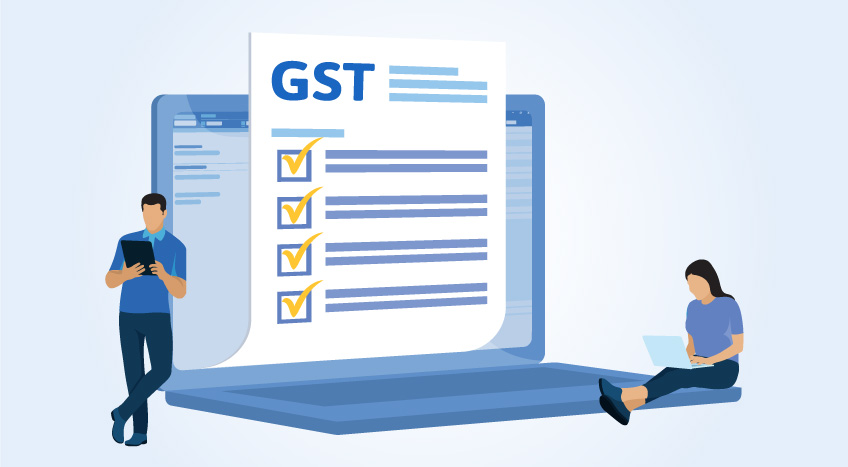- Basic understanding about CGST, SGST and IGST
- Authority of the State/Centre over these taxes which defines these taxes
- Consumption determines the type of levy – CGST/ SGST and IGST
- Difference between CGST and SGST in tabular form
- Can SGST Credit Be Used to Pay IGST?
Introduced in 2017, the Goods and Services Tax (GST) marked a major shift in India’s indirect taxation system. Its goal was to unify the country’s complex tax structure and establish a streamlined process for businesses across states and union territories. For any MSME navigating GST compliance, understanding its key components is crucial—namely, CGST, SGST, IGST, and UTGST.
Each of these components plays a distinct role depending on the nature and location of a transaction. In this blog, we break down what each GST type means, when it applies, and how it affects your business.
Basic understanding about CGST, SGST and IGST
The GST system in India was designed to streamline indirect taxation by the centre and the states into a single unified system. There are three main parts of GST, which are -
Central Goods and Services Tax (CGST)
CGST is the component of GST that is levied by the central government in India. This component is effective when goods and services are supplied or sold within a state, or intra-state transactions. The revenue earned from CGST goes to the central government. For example, when a chips manufacturer in Maharashtra sells its product to a buyer in Mumbai, the CGST component is charged, which goes directly to the central government in New Delhi.
State Goods and Services Tax (SGST)
SGST is the GST component that is collected by the state government on the same intra-state transaction. In the above example, along with CGST on the sale of chips in Mumbai by a Maharashtra-based manufacturer, an SGST is also charged. Thus, along with CGST, an SGST is also charged, where the revenue goes to the particular state government. In the example, it also goes to the Maharashtra state government. This way, both the state with the transaction is happening and the centre benefit from domestic trade equally.
Union Territory Goods and Services Tax (UTGST)
This is the component of the GST that is applicable in the Union Territories of India, including Chandigarh, Andaman and Nicobar Islands, Dadra and Nagar Haveli and Daman and Diu, Ladakh, and Lakshadweep. UTGST works on a similar line to SGST. In intra-UT transactions, that is, within the same Union Territory, UTGST goes to the government of the respective Union Territory and is levied along with CGST.
It is a component of the Goods and Services Tax (GST) system in India and is applicable when the supply of goods and/or services takes place within a Union Territory (UT) that does not have its own legislature.
Integrated Goods and Services Tax (IGST)
IGST is that component of GST that is levied on interstate transactions and imports. The upfront collection of IGST goes to the central government, which is then distributed between the centre and the destination state. This way, double taxation is avoided, and there is a smooth tax flow across state borders.
Authority of the State/Centre over these taxes which defines these taxes
A federal country such as India, where both the Centre and the States have been assigned the powers to levy and collect taxes. Both centre and state government have distinct responsibilities to perform, as per the Constitution, for which they need to raise resources.
The GST to be levied by the Centre on intra state supply of goods and / or services is Central GST (CGST) and that by the States is State GST (SGST). On supply of goods and services outside the state, Integrated GST (IGST) will be collected by Centre. IGST also applies on imports as well.
|
Transaction |
Erstwhile taxation laws - levies |
GST - levies |
Analysis |
|
Sale within the state |
Value Added Tax (VAT) & Excise / Service Tax |
CGST & SGST |
Under GST, a transaction of sale within the state shall have two taxes, SGST which share is taken by the state and Central GST which goes to the centre. |
|
Sale outside the state |
Central Sales Tax (CST) & Excise / Service Tax |
IGST |
A transaction of sale outside the state shall have only one type of tax, IGST which goes to the centre. |
Consumption determines the type of levy – CGST/ SGST and IGST
GST is a consumption based tax i.e. proceeds of taxes should be received by the state in which the goods or services are consumed and not by the state in which such goods are manufactured. Integrated GST is designed to ensure seamless flow of input tax credit from one state to another.
One state has to deal only with the Centre government to settle the tax amounts and not with every other state, thus making the process easier.
Key difference between CGST, SGST and IGST
While CGST, SGST, and IGST are three different components of GST, they need to work together to make the tax system work in a unified manner in India.
Below is a comparative analysis of these components:
|
Factor |
CGST |
SGST |
IGST |
|
Full Form |
Central Goods and Services Tax |
State Goods and Services Tax |
Integrated Goods and Services Tax |
|
Applicability |
Intra-state transactions |
Intra-state transactions |
Imports and Interstate transactions |
|
Authority |
Central Government |
State Government |
Central Government |
|
Revenue Sharing |
Only the Central Government |
Only the State Government |
The Central Government and later distributed to the destination state government |
|
Input Credit |
Can be used against CGST and IGST liability |
Can be used against SGST and IGST liability |
Can be used against IGST, CGST, or SGST |
How Does Tally Solutions Simplify GST Compliance?
If your business is still relying on spreadsheets for GST compliance, it may be time to rethink your approach. Manual processes increase the risk of errors, delays, and non-compliance. Tally Solutions offers a robust, GST-ready software solution that simplifies compliance and improves financial accuracy. Trusted by thousands of businesses across India, it brings together automation, real-time reporting, and end-to-end GST management—all in one platform.
Here are some key features that make Tally Solutions an ideal tool for managing GST:
- Automated calculations: With the input data recorded, the software automatically calculates CGST, SGST, and IGST based on transaction type and location.
- GST-compliant invoicing: It has been designed in a way that it can generate invoices meeting all legal GST requirements. This includes HSN/SAC codes and tax breakdowns.
- Real-Time GST reports: The software helps owners and leaders access GST reports like GSTR-1, GSTR-2A, GSTR-3B, and GSTR-9 for accurate filing.
- Error detection and correction: As against manual errors and formula-based errors in spreadsheets, Tally automatically identifies mismatches or missing information, thus helping avoid common errors before filing.
- Seamless data export: When uploading returns on the GST portal, users can directly export GST returns in the required format.
- Auto-reconciliation: Another huge benefit of the Tally software is that it automatically reconciles GSTR-2A data with purchase records.
- Audit trail and history: Every GST-related transaction and modification is recorded in detail, ensuring a transparent audit trail that supports compliance, traceability, and internal controls.
Tally Solutions has simplified the entire GST filing process. The calculations are automated. Reports generated are accurate. The software ensures data compliance, data validation, preview reports, and export data seamlessly. Errors are minimised, and uploading returns on the GST portal is streamlined. You save time, and risks of penalties are reduced. To learn more about the process, visit our detailed guide on GST return filing.
Recent amendments to the GST framework
Several key changes to the CGST and IGST Acts came into effect on 1st November 2024, aimed at streamlining compliance and improving clarity for businesses. Here’s a summary of the major amendments:
- Exclusion of alcohol/rectified spirit from GST
As per amendments to Section 9 of the CGST Act, 2017 and Section 5 of the IGST Act, 2017, undenatured extra neutral alcohol and rectified spirit have been excluded from the purview of GST. These goods will now be taxed under the respective state excise laws.
- Time limit for self-invoicing under RCM
Amendments to Sections 13 and 31 of the CGST Act now mandate that businesses receiving supplies liable to tax under the Reverse Charge Mechanism (RCM) must issue a self-invoice within 30 days from the date of receipt of goods or services. This new rule ensures timely documentation and facilitates better compliance and Input Tax Credit (ITC) tracking.
- Restrictions on IGST refunds for export duty goods
An amendment to Section 54 of the CGST Act introduces restrictions on claiming IGST refunds for goods subject to export duty, including exports to Special Economic Zones (SEZs). This is expected to prevent double benefits and align refund claims with duty treatment.
- Transitional credit on service invoices
Changes to Section 140 of the CGST Act allow transitional credit for services provided prior to the implementation of GST, provided proper documentation is available. This amendment helps businesses recover eligible credits and ensures a smoother transition from the old tax regime.
For business owners and decision-makers, understanding the structure and function of CGST, SGST, IGST, and UTGST is critical. These components form the backbone of India’s unified tax system and determine how intra-state and inter-state transactions are taxed and how revenue is distributed between the central and state governments.
Having clarity on each component not only ensures accurate compliance but also safeguards your business from penalties and filing errors. With a reliable, GST-enabled solution like Tally Solutions, businesses can automate tax calculations, generate compliant invoices, and access real-time reports, streamlining every step of the GST filing process.
Know Types of GST
GST
GST Software, GST Calculator, GST on Freight, GST on Ecommerce, GST Impact on TCS, GST Impact on TDS, GST Exempted Goods & Services, Reverse Charge Mechanism in GST, GST Declaration
GST Rates & Charges
GST Rates, GST Rate Finder, GST Rate on Labour Charges, HSN Codes, SAC Codes, GST State Codes
GST Returns
GST Returns, Types of GST Returns, New GST Returns & Forms, Sahaj GST Returns, Sugam GST Returns, GSTR 1, GSTR 2, GSTR 3B, GSTR 4, GSTR 5, GSTR 5A, GSTR 6, GSTR 7, GSTR 8, GSTR 9, GSTR 10, GSTR 11











